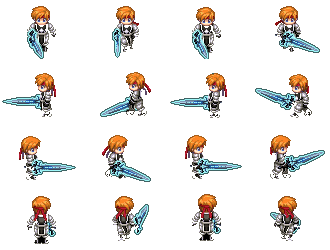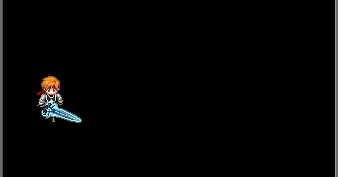
- android异步请求服务器数据示例
- Android使用criteria选择合适的地理位置服务实现方法
- 如何在Android中实现左右滑动的指引效果
- Android中关于FragmentA嵌套FragmentB的问题
- Android 通过httppost上传文本文件到服务器的实例代码
- Android实现类似于PC中的右键弹出菜单效果
- Android开发之自定义控件用法详解
- Android中传递图片的2种方法
- [Java4Android]13_面向对象基础(二)
- Android基于google Zxing实现二维码的生成
- Android实现仿网易新闻主界面设计
- android获取当前接入点信息判断是ctwap还是ctnet实例代码
- Android应用中使用Fragment组件的一些问题及解决方案总结
- Android开发技巧之永不关闭的Toast信息框(长时间显示而非系统关闭)
- Android编程实现向SD卡写入数据的方法
- 自定义RadioButton和ViewPager实现TabHost带滑动的页卡效果
- android之ContentResolver与ContentProvider介绍
- 配置android开发环境时出现eclipse获取不到ADT的解决方法
- Android中Service服务详解(二)
- 深入浅析Android手机卫士保存密码时进行md5加密
- [Java4Android]01_Java考古学
- 基于Android ListView之加载使用技巧
- Android中创建对话框(确定取消对话框、单选对话框、多选对话框)实例代码
- Android读取用户号码,手机串号,SIM卡序列号的实现代码
- Android控件系列之CheckBox使用介绍
- 解析Android中的Serializable序列化
- Android程序开发之使用Design包实现QQ动画侧滑效果和滑动菜单导航
- vbs打开ie两种方法 在VBScript中启动IE浏览器的实现代码
- Android编程之Activity中onDestroy()调用分析
- Android仿UC底部菜单栏实现原理与代码
Android App中使用SurfaceView制作多线程动画的实例讲解
1. SurfaceView的定义
通常情况程序的View和用户响应都是在同一个线程中处理的,这也是为什么处理长时间事件(例如访问网络)需要放到另外的线程中去(防止阻塞当前UI线程的操作和绘制)。但是在其他线程中却不能修改UI元素,例如用后台线程更新自定义View(调用View的在自定义View中的onDraw函数)是不允许的。
如果需要在另外的线程绘制界面、需要迅速的更新界面或则渲染UI界面需要较长的时间,这种情况就要使用SurfaceView了。SurfaceView中包含一个Surface对象,而Surface是可以在后台线程中绘制的。SurfaceView的性质决定了其比较适合一些场景:需要界面迅速更新、对帧率要求较高的情况。使用SurfaceView需要注意以下几点情况:
SurfaceView和SurfaceHolder.Callback函数都从当前SurfaceView窗口线程中调用(一般而言就是程序的主线程)。有关资源状态要注意和绘制线程之间的同步。
在绘制线程中必须先合法的获取Surface才能开始绘制内容,在SurfaceHolder.Callback.surfaceCreated() 和SurfaceHolder.Callback.surfaceDestroyed()之间的状态为合法的,另外在Surface类型为SURFACE_TYPE_PUSH_BUFFERS时候是不合法的。
额外的绘制线程会消耗系统的资源,在使用SurfaceView的时候要注意这点。
2. SurfaceView的使用
首先继承SurfaceView,并实现SurfaceHolder.Callback接口,实现它的三个方法:surfaceCreated,surfaceChanged,surfaceDestroyed。
(1)surfaceCreated(SurfaceHolder holder):surface创建的时候调用,一般在该方法中启动绘图的线程。
(2)surfaceChanged(SurfaceHolder holder, int format, int width,int height):surface尺寸发生改变的时候调用,如横竖屏切换。
(3)surfaceDestroyed(SurfaceHolder holder) :surface被销毁的时候调用,如退出游戏画面,一般在该方法中停止绘图线程。
还需要获得SurfaceHolder,并添加回调函数,这样这三个方法才会执行。
只要继承SurfaceView类并实现SurfaceHolder.Callback接口就可以实现一个自定义的SurfaceView了,SurfaceHolder.Callback在底层的Surface状态发生变化的时候通知View,SurfaceHolder.Callback具有如下的接口:
(1)surfaceCreated(SurfaceHolder holder):当Surface第一次创建后会立即调用该函数。程序可以在该函数中做些和绘制界面相关的初始化工作,一般情况下都是在另外的线程来绘制界面,所以不要在这个函数中绘制Surface。
(2)surfaceChanged(SurfaceHolder holder, int format, int width,int height):当Surface的状态(大小和格式)发生变化的时候会调用该函数,在surfaceCreated调用后该函数至少会被调用一次。
(3)surfaceDestroyed(SurfaceHolder holder):当Surface被摧毁前会调用该函数,该函数被调用后就不能继续使用Surface了,一般在该函数中来清理使用的资源。
通过SurfaceView的getHolder()函数可以获取SurfaceHolder对象,Surface 就在SurfaceHolder对象内。虽然Surface保存了当前窗口的像素数据,但是在使用过程中是不直接和Surface打交道的,由SurfaceHolder的Canvas lockCanvas()或则Canvas lockCanvas(Rect dirty)函数来获取Canvas对象,通过在Canvas上绘制内容来修改Surface中的数据。如果Surface不可编辑或则尚未创建调用该函数会返回null,在 unlockCanvas() 和 lockCanvas()中Surface的内容是不缓存的,所以需要完全重绘Surface的内容,为了提高效率只重绘变化的部分则可以调用lockCanvas(Rect dirty)函数来指定一个dirty区域,这样该区域外的内容会缓存起来。在调用lockCanvas函数获取Canvas后,SurfaceView会获取Surface的一个同步锁直到调用unlockCanvasAndPost(Canvas canvas)函数才释放该锁,这里的同步机制保证在Surface绘制过程中不会被改变(被摧毁、修改)。
当在Canvas中绘制完成后,调用函数unlockCanvasAndPost(Canvas canvas)来通知系统Surface已经绘制完成,这样系统会把绘制完的内容显示出来。为了充分利用不同平台的资源,发挥平台的最优效果可以通过SurfaceHolder的setType函数来设置绘制的类型,目前接收如下的参数:
(1)SURFACE_TYPE_NORMAL:用RAM缓存原生数据的普通Surface
(2)SURFACE_TYPE_HARDWARE:适用于DMA(Direct memory access )引擎和硬件加速的Surface
(3)SURFACE_TYPE_GPU:适用于GPU加速的Surface
(4)SURFACE_TYPE_PUSH_BUFFERS:表明该Surface不包含原生数据,Surface用到的数据由其他对象提供,在Camera图像预览中就使用该类型的Surface,有Camera负责提供给预览Surface数据,这样图像预览会比较流畅。如果设置这种类型则就不能调用lockCanvas来获取Canvas对象了。
访问SurfaceView的底层图形是通过SurfaceHolder接口来实现的,通过getHolder()方法可以得到这个SurfaceHolder对象。你应该实现surfaceCreated(SurfaceHolder)和surfaceDestroyed(SurfaceHolder)方法来知道在这个Surface在窗口的显示和隐藏过程中是什么时候创建和销毁的。
注意:一个SurfaceView只在SurfaceHolder.Callback.surfaceCreated() 和 SurfaceHolder.Callback.surfaceDestroyed()调用之间是可用的,其他时间是得不到它的Canvas对象的(null)。
3. SurfaceView实战
下面通过一个小demo来学习SurfaceView在实际项目中的使用,绘制一个精灵,该精灵有四个方向的行走动画,让精灵沿着屏幕四周不停的行走。游戏中精灵素材和最终实现的效果图:


首先创建核心类GameView.java,源码如下:
public class GameView extends SurfaceView implements
SurfaceHolder.Callback {
//屏幕宽高
public static int SCREEN_WIDTH;
public static int SCREEN_HEIGHT;
private Context mContext;
private SurfaceHolder mHolder;
//最大帧数 (1000 / 30)
private static final int DRAW_INTERVAL = 30;
private DrawThread mDrawThread;
private FrameAnimation []spriteAnimations;
private Sprite mSprite;
private int spriteWidth = 0;
private int spriteHeight = 0;
private float spriteSpeed = (float)((500 * SCREEN_WIDTH / 480) * 0.001);
private int row = 4;
private int col = 4;
public GameSurfaceView(Context context) {
super(context);
this.mContext = context;
mHolder = this.getHolder();
mHolder.addCallback(this);
initResources();
mSprite = new Sprite(spriteAnimations,0,0,spriteWidth,spriteHeight,spriteSpeed);
}
private void initResources() {
Bitmap[][] spriteImgs = generateBitmapArray(mContext, R.drawable.sprite, row, col);
spriteAnimations = new FrameAnimation[row];
for(int i = 0; i < row; i ++) {
Bitmap []spriteImg = spriteImgs[i];
FrameAnimation spriteAnimation = new FrameAnimation(spriteImg,new int[]{150,150,150,150},true);
spriteAnimations[i] = spriteAnimation;
}
}
public Bitmap decodeBitmapFromRes(Context context, int resourseId) {
BitmapFactory.Options opt = new BitmapFactory.Options();
opt.inPreferredConfig = Bitmap.Config.RGB_565;
opt.inPurgeable = true;
opt.inInputShareable = true;
InputStream is = context.getResources().openRawResource(resourseId);
return BitmapFactory.decodeStream(is, null, opt);
}
public Bitmap createBitmap(Context context, Bitmap source, int row,
int col, int rowTotal, int colTotal) {
Bitmap bitmap = Bitmap.createBitmap(source,
(col - 1) * source.getWidth() / colTotal,
(row - 1) * source.getHeight() / rowTotal, source.getWidth()
/ colTotal, source.getHeight() / rowTotal);
return bitmap;
}
public Bitmap[][] generateBitmapArray(Context context, int resourseId,
int row, int col) {
Bitmap bitmaps[][] = new Bitmap[row][col];
Bitmap source = decodeBitmapFromRes(context, resourseId);
this.spriteWidth = source.getWidth() / col;
this.spriteHeight = source.getHeight() / row;
for (int i = 1; i <= row; i++) {
for (int j = 1; j <= col; j++) {
bitmaps[i - 1][j - 1] = createBitmap(context, source, i, j,
row, col);
}
}
if (source != null && !source.isRecycled()) {
source.recycle();
source = null;
}
return bitmaps;
}
public void surfaceChanged(SurfaceHolder holder, int format, int width,
int height) {
}
public void surfaceCreated(SurfaceHolder holder) {
if(null == mDrawThread) {
mDrawThread = new DrawThread();
mDrawThread.start();
}
}
public void surfaceDestroyed(SurfaceHolder holder) {
if(null != mDrawThread) {
mDrawThread.stopThread();
}
}
private class DrawThread extends Thread {
public boolean isRunning = false;
public DrawThread() {
isRunning = true;
}
public void stopThread() {
isRunning = false;
boolean workIsNotFinish = true;
while (workIsNotFinish) {
try {
this.join();// 保证run方法执行完毕
} catch (InterruptedException e) {
// TODO Auto-generated catch block
e.printStackTrace();
}
workIsNotFinish = false;
}
}
public void run() {
long deltaTime = 0;
long tickTime = 0;
tickTime = System.currentTimeMillis();
while (isRunning) {
Canvas canvas = null;
try {
synchronized (mHolder) {
canvas = mHolder.lockCanvas();
//设置方向
mSprite.setDirection();
//更新精灵位置
mSprite.updatePosition(deltaTime);
drawSprite(canvas);
}
} catch (Exception e) {
e.printStackTrace();
} finally {
if (null != mHolder) {
mHolder.unlockCanvasAndPost(canvas);
}
}
deltaTime = System.currentTimeMillis() - tickTime;
if(deltaTime < DRAW_INTERVAL) {
try {
Thread.sleep(DRAW_INTERVAL - deltaTime);
} catch (InterruptedException e) {
e.printStackTrace();
}
}
tickTime = System.currentTimeMillis();
}
}
}
private void drawSprite(Canvas canvas) {
//清屏操作
canvas.drawColor(Color.BLACK);
mSprite.draw(canvas);
}
}
GameView.java中包含了一个绘图线程DrawThread,在线程的run方法中锁定Canvas、绘制精灵、更新精灵位置、释放Canvas等操作。因为精灵素材是一张大图,所以这里进行了裁剪生成一个二维数组。使用这个二维数组初始化了精灵四个方向的动画,下面看Sprite.java的源码。
public class Sprite {
public static final int DOWN = 0;
public static final int LEFT = 1;
public static final int RIGHT = 2;
public static final int UP = 3;
public float x;
public float y;
public int width;
public int height;
//精灵行走速度
public double speed;
//精灵当前行走方向
public int direction;
//精灵四个方向的动画
public FrameAnimation[] frameAnimations;
public Sprite(FrameAnimation[] frameAnimations, int positionX,
int positionY, int width, int height, float speed) {
this.frameAnimations = frameAnimations;
this.x = positionX;
this.y = positionY;
this.width = width;
this.height = height;
this.speed = speed;
}
public void updatePosition(long deltaTime) {
switch (direction) {
case LEFT:
//让物体的移动速度不受机器性能的影响,每帧精灵需要移动的距离为:移动速度*时间间隔
this.x = this.x - (float) (this.speed * deltaTime);
break;
case DOWN:
this.y = this.y + (float) (this.speed * deltaTime);
break;
case RIGHT:
this.x = this.x + (float) (this.speed * deltaTime);
break;
case UP:
this.y = this.y - (float) (this.speed * deltaTime);
break;
}
}
/**
* 根据精灵的当前位置判断是否改变行走方向
*/
public void setDirection() {
if (this.x <= 0
&& (this.y + this.height) < GameSurfaceView.SCREEN_HEIGHT) {
if (this.x < 0)
this.x = 0;
this.direction = Sprite.DOWN;
} else if ((this.y + this.height) >= GameSurfaceView.SCREEN_HEIGHT
&& (this.x + this.width) < GameSurfaceView.SCREEN_WIDTH) {
if ((this.y + this.height) > GameSurfaceView.SCREEN_HEIGHT)
this.y = GameSurfaceView.SCREEN_HEIGHT - this.height;
this.direction = Sprite.RIGHT;
} else if ((this.x + this.width) >= GameSurfaceView.SCREEN_WIDTH
&& this.y > 0) {
if ((this.x + this.width) > GameSurfaceView.SCREEN_WIDTH)
this.x = GameSurfaceView.SCREEN_WIDTH - this.width;
this.direction = Sprite.UP;
} else {
if (this.y < 0)
this.y = 0;
this.direction = Sprite.LEFT;
}
}
public void draw(Canvas canvas) {
FrameAnimation frameAnimation = frameAnimations[this.direction];
Bitmap bitmap = frameAnimation.nextFrame();
if (null != bitmap) {
canvas.drawBitmap(bitmap, x, y, null);
}
}
}
精灵类主要是根据当前位置判断行走的方向,然后根据行走的方向更新精灵的位置,再绘制自身的动画。由于精灵的动画是一帧一帧的播放图片,所以这里封装了FrameAnimation.java,源码如下:
public class FrameAnimation{
/**动画显示的需要的资源 */
private Bitmap[] bitmaps;
/**动画每帧显示的时间 */
private int[] duration;
/**动画上一帧显示的时间 */
protected Long lastBitmapTime;
/**动画显示的索引值,防止数组越界 */
protected int step;
/**动画是否重复播放 */
protected boolean repeat;
/**动画重复播放的次数*/
protected int repeatCount;
/**
* @param bitmap:显示的图片<br/>
* @param duration:图片显示的时间<br/>
* @param repeat:是否重复动画过程<br/>
*/
public FrameAnimation(Bitmap[] bitmaps, int duration[], boolean repeat) {
this.bitmaps = bitmaps;
this.duration = duration;
this.repeat = repeat;
lastBitmapTime = null;
step = 0;
}
public Bitmap nextFrame() {
// 判断step是否越界
if (step >= bitmaps.length) {
//如果不无限循环
if( !repeat ) {
return null;
} else {
lastBitmapTime = null;
}
}
if (null == lastBitmapTime) {
// 第一次执行
lastBitmapTime = System.currentTimeMillis();
return bitmaps[step = 0];
}
// 第X次执行
long nowTime = System.currentTimeMillis();
if (nowTime - lastBitmapTime <= duration[step]) {
// 如果还在duration的时间段内,则继续返回当前Bitmap
// 如果duration的值小于0,则表明永远不失效,一般用于背景
return bitmaps[step];
}
lastBitmapTime = nowTime;
return bitmaps[step++];// 返回下一Bitmap
}
}
FrameAnimation根据每一帧的显示时间返回当前的图片帧,若没有超过指定的时间则继续返回当前帧,否则返回下一帧。
接下来需要做的是让Activty显示的View为我们之前创建的GameView,然后设置全屏显示。
public void onCreate(Bundle savedInstanceState) {
super.onCreate(savedInstanceState);
getWindow().setFlags(WindowManager.LayoutParams.FLAG_FULLSCREEN,
WindowManager.LayoutParams.FLAG_FULLSCREEN);
requestWindowFeature(Window.FEATURE_NO_TITLE);
getWindow().setFlags(WindowManager.LayoutParams.FLAG_KEEP_SCREEN_ON,
WindowManager.LayoutParams.FLAG_KEEP_SCREEN_ON);
DisplayMetrics outMetrics = new DisplayMetrics();
this.getWindowManager().getDefaultDisplay().getMetrics(outMetrics);
GameSurfaceView.SCREEN_WIDTH = outMetrics.widthPixels;
GameSurfaceView.SCREEN_HEIGHT = outMetrics.heightPixels;
GameSurfaceView gameView = new GameSurfaceView(this);
setContentView(gameView);
}
现在运行Android工程,应该就可以看到一个手持宝剑的武士在沿着屏幕不停的走了。
- Android编程实现系统重启与关机的方法
- Android递归方式删除某文件夹下的所有文件(
- Android输入框控件ClearEditText实现清除功
- 在当前Activity之上创建悬浮view之WindowMa
- Android中layout属性大全
- Android上使用jspf插件框架的方法
- Android编程经典代码集锦(复制,粘贴,浏览器